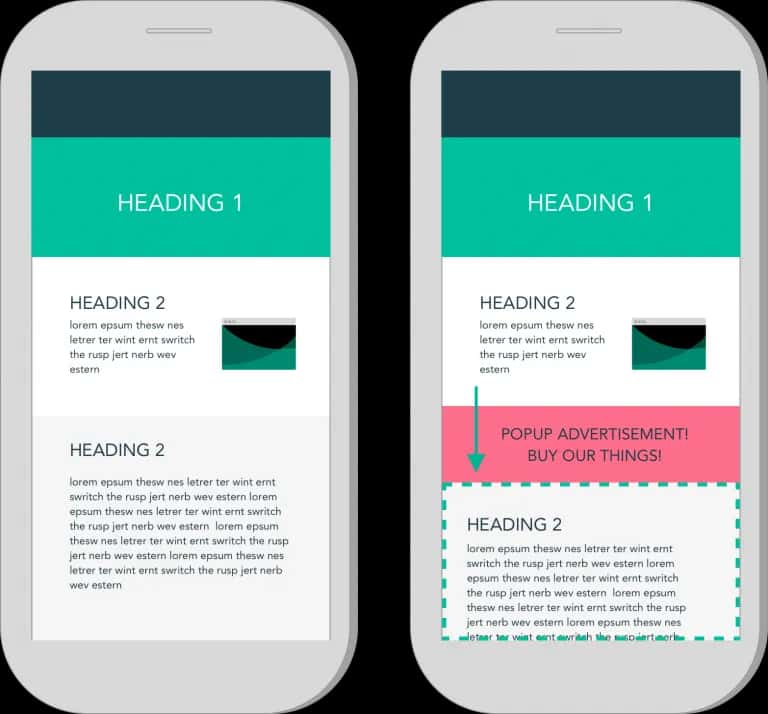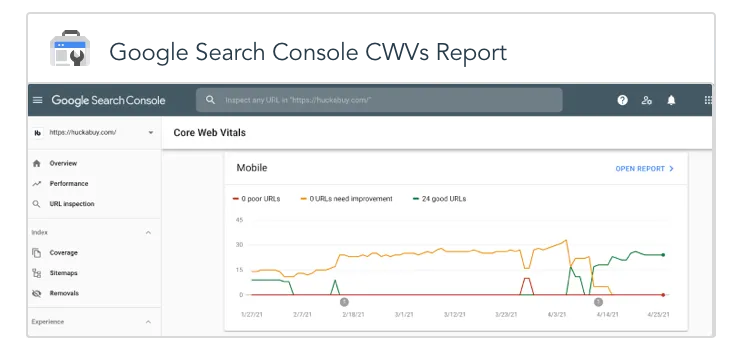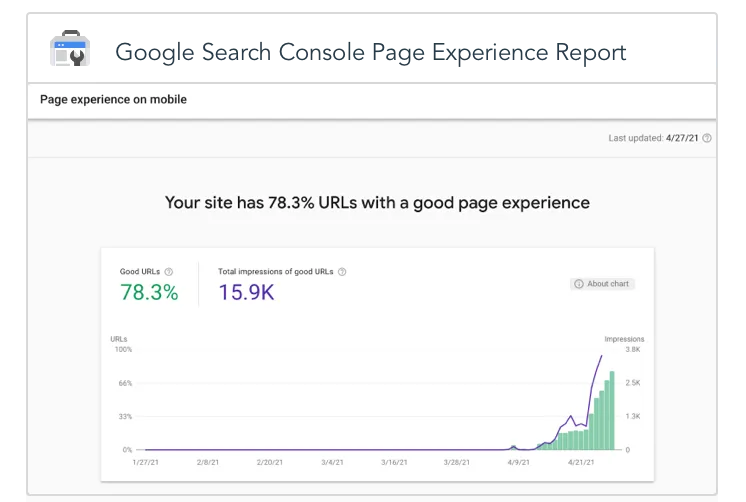Core Web Vitals
Why Page Speed is now a bigger SEO ranking factor

What Are The Google Core Web Vitals?
Core Web Vitals are a set of metrics that help Google measure how well a specific page is providing a quality user page experience. The Core Web Vitals are three metrics, among a list of Page Experience metrics, that specifically measure page performance and score different aspects of load time either “poor,” “needs improvement,” or “good.”
The three Core Web Vital metrics are:
- Largest Contentful Paint (LCP)
- First Input Delay (FID)
- Cumulative Layout Shift (CLS)
Google introduced the Core Web Vitals as ranking signals in June 2021 to accomplish their mission of offering their search engine users the best user experience. Read more to learn about what these metrics exactly measure, how to track them for your own website, and how you can improve these metrics and your overall site performance.
The Purpose of Core Web Vitals
Google has been on a mission to simplify how easy it is to measure, monitor, and optimize for a delightful website experience. But user experience can’t be captured in a single metric or single representative user. A series of milestones (based on field data) go into the equation. The Core Web Vitals are some of the most important metrics in measuring these page load milestones. These three metrics also measure distinct facts of the user experience, specifically: the speed, responsiveness, and stability of a page based on field data from the Chrome User Experience Report (crUX).
Defining the Three Core Web Vitals
largest contentful paint (LCP)
Largest Contentful Paint (LCP) takes aim at loading performance by measuring how fast the largest, most important element in the initial viewport (above the fold). This could be a hero image, text, video, or any other page element. A score under 2.5 seconds is considered “good” or passing. Learn more here.
first input delay (FID)
First Input Delay (FID) takes aim at responsiveness by measuring how fast the page reacts to users inputs, such as the clicking of a link or button. A score under 100 milliseconds is considered “good” or passing. Learn more here.

cumulative layout shift (CLS)
Cumulative Layout Shift (CLS) takes aim at visual stability by measuring how many elements on the page move around as more images, advertisements, and text are loaded. A score under .1 is considered “good” or passing. Learn more here.

Evolving Core Web Vitals
Google has publicly stated that the current signals are not perfect and that future improvements and/or additions should be expected. The current set for 2021 focuses on loading, interactivity, and visual stability. But, they should be expected to evolve over time. For example, benchmarks for Cumulative Layout Shift have already changed once since Google’s announcement about this algorithm update last year. Webmasters, of course, will be notified when changes are introduced.
Other Page Experience Metrics
The three Core Web Vitals are joining four pre-existing metrics to form the page experience ranking signal: mobile-friendliness, safe-browsing, HTTPS, and intrusive interstitials.
What you'll learn in this video
- How to measure Core Web Vitals
- The difference between field and lab data testing and monitoring tools
Schedule a Page Speed Demo
How to Monitor and Improve Core Web Vitals
Core Web Vitals scores are calculated based on field data from the Chrome User Experience report. With that said, there is additional worthwhile lab data to reference on the journey to improving Largest Contentful Paint, First Input Delay, and Cumulative Layout Shift scores. We will look at both data in this section, as well as Google tools and reports you can easily access and use to measure, monitor, and fix these scores on your website.
Field Data
One of the key points about Core Web Vitals is that they are based on field metrics or real user metrics (RUM). Google uses anonymous data from Chrome users for feedback, which informs the Chrome User Experience report (crUX). This data is shown in both the Pagespeed Insights tool and the Core Web Vitals report in Search Console.
The Chrome User Experience report is based on page views. This means your most popular pages will have a large influence on your data. This also explains why there may be a notification of insufficient data shown in the PageSpeed Insights report for certain websites, particularly ones with low traffic.
Also, field data that populates in the Core Web Vitals report is slow to update after changes are made because they are based on the last 28 days of data in the Chrome User Experience Report, and more specifically, the 75th percentile of those scores for the more accurate reflection of site performance.
Lab Data
Lab data comes from tools, like Google Lighthouse, that load pages in a simulated environment on controlled network settings and devices without user input. This means it isn’t always reflective of the user experience. First Input Delay, for example, cannot be measured in this environment. However, this data is still instructive and can give you a good idea as to whether you are on the right track with optimizations. Total Blocking Time, for example, has been recognized by Google as a good lab proxy for First Input Delay.
PageSpeed Insights
The PageSpeed Insights tool shows an overall score at the top of the page calculated based on Lighthouse data. Directly below that score, however, is a section on data from the Chrome User Experience Report. This shows scores for each of the three Core Web Vitals, as well as First Contentful Paint. There is also a note stating whether the URL passes the Core Web Vitals assessment based on data from the previous 28 day collection period.
When testing a URL, you may see the alert that “The Chrome User Experience report does not have sufficient real-world speed data for this page.” This is because Google collects anonymized data for the report and there must be enough page loads to report for sufficient data collection. Learn more about this tool here.

Core Web Vitals Report
The Core Web Vitals report shows how your pages perform for each of the three metrics based on real-world usage data. URLs are grouped together by performance status (“poor”, “needs improvement”, and “good”) for Largest Contentful Paint, First Input Delay, and Cumulative Layout Shift on mobile and desktop. After reviewing this report, you can make changes to your pages. Once those have been made you can “validate these fixes” in the report. This starts a new 28-day monitoring session. Until then, you will see a “pending” status in your report for the particular fixes. After the 28-day session, you will either see a “passing” or “failing” status. Learn more about this report here.

Page Experience Report
The Page Experience report is a new Google report that shows data on each of the page experience metrics over the previous 90 days, specifically the percentage of URLs on your site that provide a “good” page experience and the number of impressions those URLs have received in organic search results. For a URL to have a “good” page experience, it must pass the Core Web Vitals assessment and there must be no issues associated with mobile usability, security, HTTPS, or advertising experience. Learn more about this report here.

Why did Google release new ranking signals? What does this mean for SEO?
In addition to improving the quality of text, images, and videos (the content) on page, Google has also been very interested in improving, essentially, the usability of pages. They want the experience of interacting with content to be as delightful as the content itself. These new rankings signals are a move on Google’s part to incentivize websites to build pages that match a certain user experience quality standard.
The new page experience signal
Currently, the Google gauges user experience on whether a site is mobile friendly, offers https and safe browsing, and has no instructive advertisements. Core Web Vitals expands this signal.
The updated page experience ranking signal will consist of the three Core Web Vitals (Largest Contentful Paint, First Input Delay, and Cumulative Layout Shift), mobile-friendliness, safe browsing, HTTPS, and no intrusive interstitials.
Google will only apply this ranking signal to the mobile versions of the site and they will evaluate on a per-URL basis.
When these changes will be instituted
Originally, Google announced that the algorithm update would be rolled out in May 2021. In April, Google announced that it would be delayed to June 2021 with a slower rollout over the summer, culminating in August.
What this will look like in search results
Google recently announced that there will be a page experience “badge” assigned to URLs in search results that are passing the Core Web Vitals assessment, similar to how Google gives badges for AMP pages. It’s an indication of how much importance Google is placing on user experience, and it’s also a help to users who now have a better indication ahead of time as to whether a site will be delightful to visit.
From Google:
“We believe that providing information about the quality of a web page's experience can be helpful to users in choosing the search result that they want to visit. On results, the snippet or image preview helps provide topical context for users to know what information a page can provide. Visual indicators on the results are another way to do the same, and we are working on one that identifies pages that have met all of the page experience criteria. We plan to test this soon and if the testing is successful, it will launch in May 2021"
How big a change this is going to be
Remember that Google has hundreds of ranking signals, that they work in concert, and that the impact of any single one is usually not that big. However, if your site is scoring poorly on any of these metrics and you are competing in your industry for highly desired keywords, it could make a big difference. For example, you and your competitors could have equally great content for a particular search result, but the competitor is passing the Core Web Vitals assessment, while your site is failing it. In a case like that, this new ranking factor could serve as one of the tiebreakers.
Think of it as an indirect ranking factor as well. Users love fast sites and this influences their search behavior. Fewer will retreat back to the search results to click on another link, they’ll spend more time on pages, and they’ll visit more pages per session as well. Google just released a statistic, for example, that users are 24% less likely to abandon page loads when the URL passes the Core Web Vitals assessment.
Also, keep in mind that page speed - and user experience in general - are the types of ranking factors that transcend SEO. They have a huge impact on all marketing channels. So, by optimizing for this update, your business could see great returns on investment beyond the organic channel.
Page Experience Report
The Page Experience report is a new Google report that shows data on each of the page experience metrics over the previous 90 days, specifically the percentage of URLs on your site that provide a “good” page experience and the number of impressions those URLs have received in organic search results. For a URL to have a “good” page experience, it must pass the Core Web Vitals assessment and there must be no issues associated with mobile usability, security, HTTPS, or advertising experience. Learn more about this report here.
Huckabuy Page Speed boosts Core Web Vitals
Huckabuy Page Speed is a software product that instantly improves your website’s Largest Contentful Paint and First Input Delay scores in order to pass the Core Web Vitals assessment and benefit from the new page experience ranking factor in organic search. Consider this solution if you would prefer to save time, money, and development resources for other high-leverage marketing and site performance initiatives.